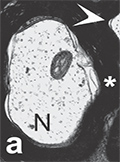The eLitMed.hu medical portal uses computer cookies for convenient operation. Detailed information can be found in the Cookie-policy.
Clinical Neuroscience - 2014;67(09-10)
Content
[Grey matter atrophy in patients suffering from multiple sclerosis]
[White matter lesions are defining characteristics of multiple sclerosis (MS), whereas grey matter involvement is a less recognised attribute. Recent investigations using dedicated imaging approaches have made it possible to depict cortical lesions. Additionally, grey matter atrophy may be estimated using various methods. Several studies have suggested that grey matter atrophy closely correlates to clinical disability. In this review we have collected information on grey matter atrophy in MS and the effect of disease modifying therapies upon brain atrophy.]
[The relevance of traumatic life events in schizophrenia spectrum disorders]
[The central goal of this manuscript was to review literature about the interconnections of traumatic life events and symptoms of schizophrenia spectrum of the last 15 years. First of all, the stress-diathesis model and the traumagenic neurodevelopmental model are shortly presented. Psychological effects of traumas and specific psychotic symptoms in connection with traumatic events are discussed. The course of the disease in patients affected by previous traumas and possible mediating factors are also addressed. Studies of both clinical and community samples are cited. It was also our aim to review literature about the neurobiological and neurocognitive processes in people affected by schizophrenia and/or traumatic life events. The role of prefrontal and medial temporal regions are explored with a special emphasis on contextual memory and hippocampal functioning. Finally, the possible effects of exploring traumatic life events on the treatment of schizophrenia are discussed.]
[Complex approaches to study complex trait genetics in multiple sclerosis]
[Multiple sclerosis (MS) is a complex trait disorder defined by several genes and their interactions with environmental factors. A comprehensive exploration of the susceptibility variants had not been feasible until recently when new developments in biotechnology and bioinformatics made possible sequencing of the whole human genome, cataloguing of nucleotide variants and alignments of these variants in haplotypes. Earlier observations from epidemiological, candidate gene and linkage studies provided ample evidence to support a complex genetic determination of MS. New biotechnology and bioinformatics resources have been recently applied to further successful explorations of the disease. These efforts were paralleled by more careful and reliable ascertainments of disease phenotypes, collaborations among specialized centers to generate sufficient sample size and involvement of clinician-scientists capable of working both on the clinical and scientific study sides. Data obtained from the whole genome association studies (GWAS) elevated our understanding of MS genetics to a new level by identifying an extensive list of genetic determinants. Pathway analyses of MS-associated variants provided evidence to support the immune etiology of the disease. Future research will likely explore how environmental factors interact with the genome, and contribute to the abnormal immune activation and inflammation. This review summarizes the outcomes of MS genetic explorations including those of recent GWAS, and highlights practical consequences of genetic and genomic studies by pointing out as to how the derived data facilitate further elucidation of MS pathogenesis. A better understanding of disease processes is necessary for future advancements in therapeutics and the development of disease prevention strategies.]
[Mechanism of the “dark” axonal degeneration in the central nervous system]
[Background and purpose - In the central nervous tissue, two types of transsection-resulted axonal degeneration are generally accepted: “watery” and “dark”. The present paper deals with the assumption that the mechanism of this kind of “dark” axonal degeneration has a relationship with that of the “dark” neuronal degeneration. Methods - A minute stab wound is inflicted in the parietal cortex of the rat brain. From 1 h to 3 months postinjury, the resulted ultrastructural events in two distant regions of the corticospinal tract (internal capsule and C3 region of the corticospinal tract) are studied. Results - As a novel finding, the first morphological process of “dark” axonal degeneration was found to consists in a striking reduction of the distances between neighboring neurofilaments, which were readily distinguishable and apparently undamaged. This pattern (compacted ultrastructure) persisted for hours. By day 1 postinjury, the compacted axoplasmic elements aggregated into a homogenous and dense (“dark”) mass in which hardly any ultrastructural elements could be distinguished. Surrounded by apparently normal or mildly abnormal myelin sheat, this mass underwent a non-isotropic shrinkage during the next three months. Morphological signs of phagocytosis were insignificant. Conclusion - The ultrastructural events during the first day post-injury suggest a non-enzymatic mechanism as an alternative to the prevailing molecular-biological mechanism.]
[P-wave dispersion doesn’t increase in patients with epilepsy]
[Aim - Epileptic seizures have occasionally been associated with cardiac conditions as atrioventricular blocks, long QT syndrome etc. P-wave dispersion (PWD), which is the difference between the longest (P max) and shortest P-wave duration (P min), is considered as a forerunner of atrial fibrillation. In this study, we investigated P-wave dispersion (PWD) in epileptic patients; based on the hypothesis that microthromboembolism may occur in atrial fibrillation. Methods - Seventy five patients with mixed types of epilepsy and 50 age and sex matched healthy individuals were included into the study. P max, P min and PWD values were calculated for each subject from an ECG. Results - The mean age of subjects in the epilepsy group and control group were similar (p>0.05). P max in patients with epilepsy was 125.1±0.7 ms, P min was 67.3±10.3 ms, and PWD was 57.6±8.3 ms while these values in the control group were 116.8±11.0 ms, 66.5±5.5 ms and 46.8±7.1 ms, respectively. There were no statistically significant difference between two groups (p>0.05). Conclusions - PWD does not increase in patients with mixed types of epilepsy. Therefore we believe that microthromboembolism duo to atrial fibrillation can’t cause epileptic seizures in patients with no structural heart disease.]
[Retinal ganglion cell layer and visual function in patients with progressive external ophthalmoplegia caused by common mtDNA deletion]
[Aim - Mitochondrial (mt) disorders are metabolic conditions with multiorgan involvement, which often cause neuroophtalmological symptoms. The aim of the study was to investigate the relation between progressive external ophthalmoplegia (PEO), visual pathway and mitochondrial DNA (mtDNA) mutations in patients younger than 55 years of age. Methods - Five female patients (35 to 53 years of age) with mithochondrial disease were investigated. Automated threshold perimetry (Octopus G2 test), scanning laser polarimetry (GDx-VCC and GDx-ECC) and Fourier-domain optical coherence tomography (RTVue-100 OCT) were used in addition to detailed ophthalmological examination and evaluation of visually evoked potentials (VEP). Frequent mutations of the mtDNA were investigated in the patients’ blood and muscle samples. Results - PEO of various severity levels was found in all patients, using clinical tests. Genetic testing showed “common deletion” of mtDNA in all cases. For both eyes of 4 patients functional and structural ophthalmic tests had normal results. In one patient decreased visual acuity, reduced retinal nerve fiber layer thickness and prolonged L3 VEP latency time were found without optic disc damage and visual field deterioration. Conclusion - In 4 of our 5 patients with PEO due to common deletion of mtDNA retinal ganglion cells and visual function remained normal for a long period of life.]
[Prosthodontic treatment of an edentulous epileptic patient with an implant-retained overdenture. A case report]
[This report describes the treatment of a completely edentulous, mentally retarded patient with epilepsy with an implantretained overdenture, anchored by a locator system. The intractable epileptic condition of the patient with frequent grand mal seizures and complex partial seizures required a stable, well retained prosthesis, however the maxilla and the mandible were severely atrophied. The bone volume of the maxilla allowed the placement of only two implants at the region of the canines, compared with the generally required four. On long time recall, after one year, patient’s chewing ability was satisfactory.]
[Anti-signal recognition particle autoantibody positive myopathy]
[The idiopathic inflammatory myopathies are systemic, autoimmune diseases characterized by proximal symmetrical muscle weakness. We review the myositis-associated and myositis-specific autoantibodies, among them the anti- SRP autoantibody. Among those autoimmune myopathy cases, that are associated with autoantibodies, we can detect anti-SRP autoantibody positive myositis cases. We describe the role of signal recognition particle, also its structure and role in protein biosynthesis. We review how the necrotizing autoimmune myopathy is identified, what kind of differences are presented in relationship with the classical polymyositis cases. As we will see the anti-SRP titer correlates with the activity of the disease. We serve some examples from the literature how the disease looks in the childhood and also some rare cases from the literature. At the end of our review we present a case report to draw attention to the importance of the disease.]
[Account about scientific meeting of Környey Society in 2014]
[Account about scientific meeting of Környey Society in 2014 2014;67(09-10)]
1.
Clinical Neuroscience
[Headache registry in Szeged: Experiences regarding to migraine patients]2.
Clinical Neuroscience
[The new target population of stroke awareness campaign: Kindergarten students ]3.
Clinical Neuroscience
Is there any difference in mortality rates of atrial fibrillation detected before or after ischemic stroke?4.
Clinical Neuroscience
Factors influencing the level of stigma in Parkinson’s disease in western Turkey5.
Clinical Neuroscience
[The effects of demographic and clinical factors on the severity of poststroke aphasia]1.
2.
Clinical Oncology
[Pancreatic cancer: ESMO Clinical Practice Guideline for diagnosis, treatment and follow-up]3.
Clinical Oncology
[Pharmacovigilance landscape – Lessons from the past and opportunities for future]4.
5.













